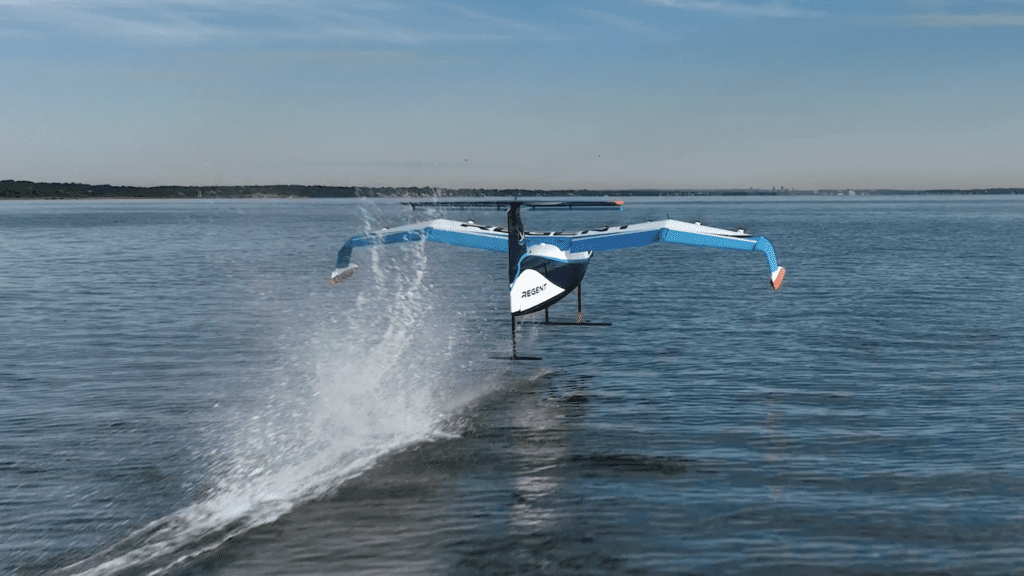
The quarter-scale prototype of Regent’s seaglider recently performed its first successful flight during a series of flight demonstrations in Rhode Island. (Photo: Regent)
Regent announced this week that its all-electric quarter-scale seaglider technology demonstrator completed its first flight. The seaglider is the first vehicle to take off from a controlled hydrofoil to wingborne flight, the company claims. The hydrofoiling increases the seaglider’s wave tolerance while on the water, and it retracts once the aircraft takes flight.
Following the initial flight demonstration, Regent completed a series of flights in Narragansett Bay in Rhode Island. The company is targeting entry into commercial service by 2025 following passenger-carrying test flights that are expected to start in 2024. Orders for Regent seagliders currently total more than $7 billion.
Currently, the team at Regent is focusing on development of the full-scale prototype, which will have a 65-foot wingspan (the quarter-scale demonstrator has an 18-foot wingspan).
“Regent is the first team in history to overcome the deficiency of low wave tolerance with past designs by combining high-speed hydrofoils with ground-effect flight—a crucial innovation that will revolutionize coastal transit,” remarked Mike Klinker, co-founder and Chief Technology Officer (CTO), in the announcement by Regent.

Regent’s seaglider prototype in flight (Photo: Regent)
Last month, Regent selected Siemens Digital Industries Software to provide its Xcelerator portfolio of software and services for the seaglider. Regent’s team is also partnering with Allocortech, an aerospace engineering company that will provide avionics components for Regent’s vehicle.
Billy Thalheimer, CEO and co-founder of Regent, spoke with Avionics International about flight testing their seaglider prototype and about the company’s long-term vision.
Avionics: How does Regent’s electric seaglider work?
Thalheimer: The hydrofoils, which are basically underwater wings, give us high wave tolerance and maneuverability through a harbor. Once we get through the harbor, traffic dies down, and we’re in open water, we take off. The vehicle flies within a wingspan of the surface on a cushion of air, known as ground effect, that creates aerodynamic efficiencies. We can go 180 miles on a totally battery-powered system with existing battery technology.
Seagliders really combine the hydrofoiling wave tolerant maneuverability with the speed of an aircraft out in the open waters to create a vehicle that is essentially the speed of high-speed rail and the convenience without the infrastructure costs—the speed of an aircraft and the convenience of a boat. It fills a gap in regional travel—Los Angeles to San Francisco, Boston to New York City—these are the really painful routes, and seagliders are solving that problem.
Avionics: What is the operational experience of the seaglider like?
Thalheimer: It’s technically operated by a captain, not a pilot. You don’t fly seagliders, you drive them. The controls are boat controls—left and right, fast and slow—think all two-dimensional. Regent has taken all the hard, historically dangerous parts of aviation—the roll, pitch, altitude control, take-off and landing transitions—and we’ve wrapped that up into our digital flight control system which controls all these phases. With our quarter-scale prototype, we just have a remote operator, but with our full-scale vehicle we will have a captain at the helm doing boat controls, and our digital flight control system is doing the rest. It’s a hugely lower bar to entry compared to the years it takes to get a pilot’s license.

In August, Regent received an Approval in Principle (AiP) from Bureau Veritas Marine & Offshore for the Viceroy seaglider. The AiP offers a clear path for the vehicle’s classification as a wing in ground effect (WIG) maritime vessel. (Photo: Regent)
Avionics: When do you expect to complete development of the full-scale prototype?
Thalheimer: The goal is to have humans flying by the end of 2024.
Avionics: What are some of the challenges facing the company over the next few years?
Thalheimer: It’s really been about proving that this technology works—proving that we can transition between the floating, foiling, and flight modes which we’ve now proven on the quarter-scale prototype. We’ve also been proving that the technology will scale to the full-scale model, which we’ve done. We recently announced completion of our full-scale blown wing testing—a full-scale section of the wing with multiple propellers on it that shows us how the aerodynamics will scale up.
We’ve now completely de-risked the technology. The next step is really just implementation. We’ve already reached our first major milestone with our maritime regulator, Bureau Veritas, that’s called the Approval in Principle.
Avionics: Could you share any details about Regent’s long-term strategy?
Thalheimer: We want seagliders to be part of the transportation canon, where people are used to taking seagliders on all coastal routes. In terms of our path toward commercialization, we’ll size up our prototype, build something with roughly a 65-foot wingspan, build our full-scale prototype, set up our manufacturing line, commercialize these, and get them into hands of our customers who are already ready for delivery. That’ll be by the end of 2025 for commercial operations. From there, we’ll build them even bigger. Our first model is called Viceroy with 12 passengers. From there, we’re going to build Monarch, a 100-passenger vehicle. That’s the goal—to have 100-passenger Monarch seagliders on every coast on the planet, servicing the 40% of the world’s population that lives in coastal communities.